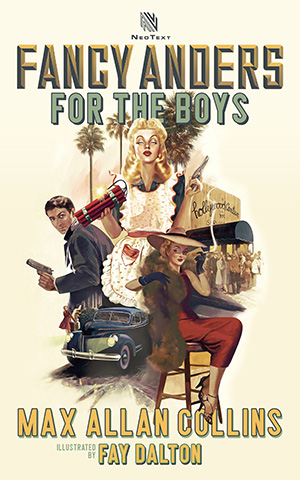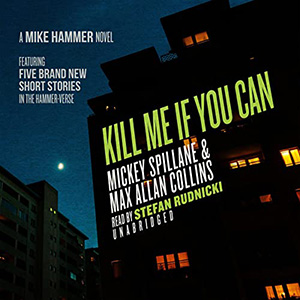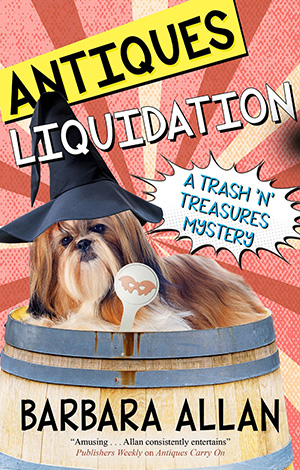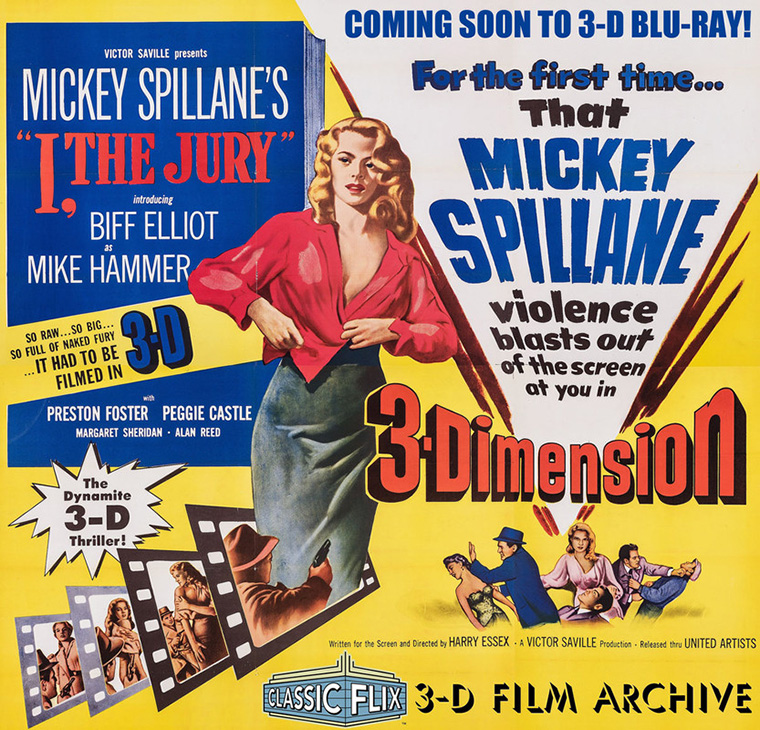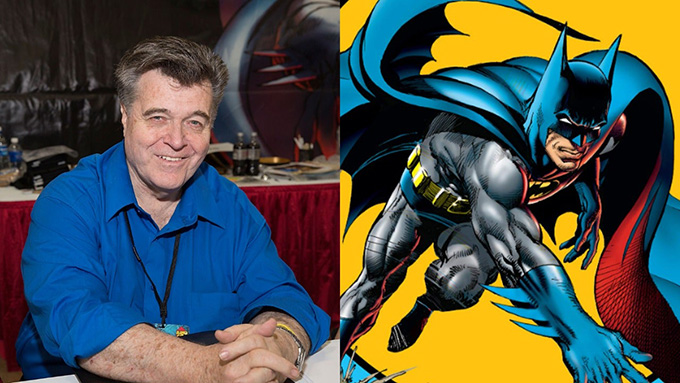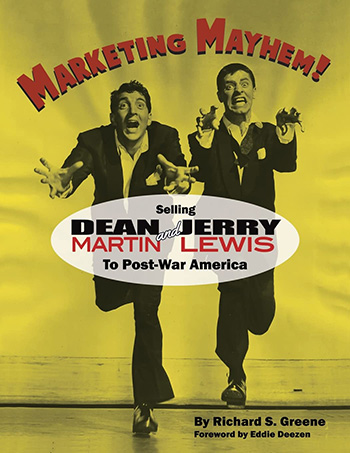Out of the blue, two nice reviews of my novella Fancy Anders For the Boys popped up on the Internet.
Here’s one from that pro’s pro, writer Ron Fortier, at his Pulp Fiction Reviews site. Ron has, in part, a very personal response that is quite fascinating.
By Max Allan Collins
Illustrated by Fay Dalton
Neo Text
118 pgs
This is Collins’ second book featuring Hollywood debutante turned detective, Fancy Anders, set in the early days of World War II. What with Pearl Harbor fresh in the minds of most Americans, the people in Los Angeles right worry about a possible Japanese invasion and the Army quickly establishes military outpost in the hills overlooking the city. Many of these set up with anti-artillery installations.
With that many boys in uniform soon flooding the streets of Hollywood, the movie community comes together under the leadership of actors John Garfield and Bette Davis to open a canteen exclusively to cater to these servicemen and staffed by cinema stars and young, beautiful ingénues.
When Army Intelligence learns of possible enemy saboteurs targeting the famous Hollywood Canteen, Fancy is recruited, along with several of her girl friends, to pose as canteen hostesses and ferret out the foreign agents. Once again, Collins uses his considerable imagination to drop the reader into the middle of one of Hollywood’s most memorable locales. Through his words, it is so easy to see the beautiful ladies, the eager young men away from home and hear the big band music. It all comes alive against a backdrop of a world turned upside in the throes of war.
“Fancy Anders – For the Boys” is a fun read. Especially for this reviewer, whose father, Pfc. George Fortier served on one of those gun crews and spend his 1942 Thanksgiving, along with two other men, at the home of crooner Bing Crosby and his family. All before he shipped out for the Philippines and three years of hell.
And here is another great review, this one from GoodReads (unfortunately, unsigned):
October 1942. With her private detective daddy in the OSS chasing saboteurs, Fancy is stuck playing receptionist/cleaning-gal at the empty Anders Confidential Inquiries office. But then the 24-year-old Barnard grad – expert in shooting, flying and jujitsu – is recruited back into action.
Hollywood, with Bette Davis and John Garfield leading the charge, has put together a night club where servicemen are served by waiters and waitresses with famous faces, from Gable to Dietrich, from Abbott to Costello. With starlets acting as hostesses, gorgeous Fancy fits right in. But this pistol-packing mama knows her real job is solving the murder of Who Killed the Hostess – a Victory Girl who became an LA battle casualty. In the meantime, saboteurs are targeting the Canteen for maximum damage, hoping to wipe out half the stars in Tinsel Town and blast a hole in America’s morale.
Portraying the times vividly with his trademark historical accuracy, Mystery Writers of America grandmaster Max Allan Collins has created a series protagonist both of her time and far ahead of it. Lavishly illustrated by James Bond artist, Fay Dalton.
The three Fancy Anders novellas are designed as essentially a serialized novel, in the hope they will be collected (Fay Dalton’s great illos and all). My structural pattern was Hammett’s great The Glass Key. Fay is working on the third novella’s illustrations right now (Fancy Anders Goes Hollywood).
Neo Text bought them as e-books but, at my request, have also made them available in book form. This has caused some confusion from readers who can’t figure out why the books are so short, although the books at Amazon are clearly listed as novellas.
Fay’s illos (cover excepted) appear in black-and-white in the physical books and in color in the e-books. My hope is that they will be in color when the three novellas are eventually collected, and in fact I’ll probably insist they do. We have not gone out to publishers about the collected novel version as yet.
This was a Covid lockdown project, largely, and one I truly loved doing, from the research through the writing. Fancy is sort of a young Ms. Tree, though she definitely has her own personality. Within the context of my work, the novellas are reliably tough, though not as extreme in that regard as Mike Hammer, Nate Heller and Quarry.
You can get them at Amazon. Here’s Fancy Anders Goes to War.
And here’s Fancy Anders For the Boys.
As I’ve mentioned here before, Skyboat Media has done phenomenal audiobooks of the Fancy novellas, with full sound effects, music and a fine female narrator in Gabrielle De Cuir.
The Amazon links I provided will also take you to ordering info on the e-books and the audios mentioned above. But of course my preference is physical media.
Fancy Anders Goes to War is $6.99 and Fancy Anders For the Boys is $5.99 in physical book form.
My ongoing rants about my love of physical media and disdain for e-books and streaming video probably needs some clarification.
Nothing wrong with e-books. If I were younger, particularly if I were commuting by train to work or doing a lot of flying on commercial airlines for business, I would certainly have a Kindle. My son Nate has long read books on Kindle and, when he really likes them, gone on to buy those books in their proper physical media form.
A great deal of my income comes from e-books, as the links I provide here to Amazon sales on a fairly regular basis indicate. I have been very fortunate to have been one of the authors who early on was approached by Amazon, and they have kept me in print (and have sent regular checks) at a time in my career when that comes in very handy indeed. They publish physical media versions, too, but the e-books are the moneymakers.
Frankly, I was one of the handful of living authors approached by Amazon for my backlist – which included not only Nate Heller but Mallory and the “Disaster” series and a few standalones. Ian Fleming was one of the others, for example, all deceased except me. For a while they were publishing new novels of mine – including the very successful Reeder and Rogers political thriller trilogy, co-written by my pal Matt Clemens – though the current editorial staff expresses no interest in publishing new material by me.
No harm, no foul. What they already have continues to generate sales. The most recent titles are the two Krista Larson novels, Girl Most Likely and Girl Can’t Help It, which continue to sell if not at a clip at a steady pace.
But my frustration with the streaming services continues, and the writers and actors who are on strike are actively seeking help in that area, understandably. As a consumer, I am angry – but not even a little surprised – to see them (post-Covid lockdown) eliminating all sorts of stuff that I might have wanted to watch, and this includes things I bought for my library. Things like the 1950 Li’l Abner and the Sidney J. Furie The Lawyer have disappeared after I bought them, supposedly permanently.
If you drop by here regularly, you’ll know I set out to show Barb and myself every Raymond Burr-era Perry Mason episode that was based on an Erle Stanley Gardner novel or story. We have completed that mission, and I think it adds up to 90 episodes or so (remarkable that an American series did so many adaptations of the source material).
But during the relatively short time it took to do that, a whole season (season 7) disappeared from Paramount+, and a number of episodes from the other seasons disappeared without a trace much less a warning. These tended to be Gardner-derived episodes.
Fortunately, I owned the entire nine-season run on DVD and had been watching the Paramount+ episodes only because they were of the higher high-def quality. You haven’t lived till you’ve examined the wrinkles on the faces of Hamilton Burger and Lt. Arthur Tragg in high-definition.
“Incompetent, irrelevant and immaterial!” you say.
Well, I’m fussy. And some who’ve been witnessing these irrational tirades of mine frown and waggle a finger – maybe it’s all well and good for an incredibly wealthy, world-famous author (pause for my hysterical laughter) to spend some of his endless funds on one Blu-ray and actual physical book after another. And it’s true that I wallow in laserdiscs, DVDs, Blu-rays and 4K discs, and that books are stacked everywhere around here waiting in hopeless desperation to be read.
But I never meant to imply that the unreliability of the streaming services and the convenience of e-books meant that I expected you to spend your food money on physical media. Only an obsessive idiot like myself – and I am not alone, I assure you – would buy as many discs and books as I do, despite the dwindling number of years that I face ahead to actually watch or read them.
What I mean to suggest about DVDs, Blu-rays and 4Ks is that if you like a movie or TV series, if it’s one of your favorites or even if it’s just something you might think revisiting is a distinct possibility, buying those movies (and/or TV shows) on physical media is well worth considering.
And as for e-books, my son Nate’s approach makes a world of sense – read it on Kindle (or whatever), and if you really, really like it, invest in a physical copy for your book shelf.
Books by me, for example.
I intend to start writing a new novel tomorrow (Monday, July 17, as I type this) – Quarry’s Return. It is, not surprisingly, for Hard Case Crime.
I spent all of this past week (including earlier today) on plotting the novel – specifically, writing a 2500-word synopsis. In the past, I have not always plotted in this much depth. My first few novels – Bait Money, No Cure for Death, and The Broker (aka Quarry) – were not plotted at all. I just flew by the seat of my pants.
No Cure for Death – a mystery – found me having to write two chapters to explain what the eff had been going on. I swore to never put myself in that position again, and never did. Crime novels were less a problem, because they don’t always include a strong mystery element. But as the years passed, and boy have they passed, I gradually began to need to plot.
It begin with plotting just a few chapters ahead. By recent years, I’ve come to need a full chapter breakdown. On the other hand, I frequently depart from the synopsis when the characters decide to come up with things of their own to do that I hadn’t anticipated. So I almost always have to re-plot a few times during the writing of a novel.
The more detailed plotting began with True Detective in the early ‘80s – I was dealing with history and a certain amount of plotting had already occurred by way of events. Surprisingly, the historical nature of the material did prevent the need to re-plot as I went along, because the characters would again surprise me and, because I continue to research as I write, new information would present itself and demand attention.
The ESO network has published another Ron Fortier review, of the Spillane/Collins The Menace, a book you should consider picking up. It’s a horror novel, Spillane-style, plus two bonus stories. From Wolfpack.
Finally, this is a rather wonderful review (in French – you may have to rely on your browser to translate) of the graphic novel, Road to Perdition. One of the smartest, most in-depth reviews of that work I’ve seen.
M.A.C.


